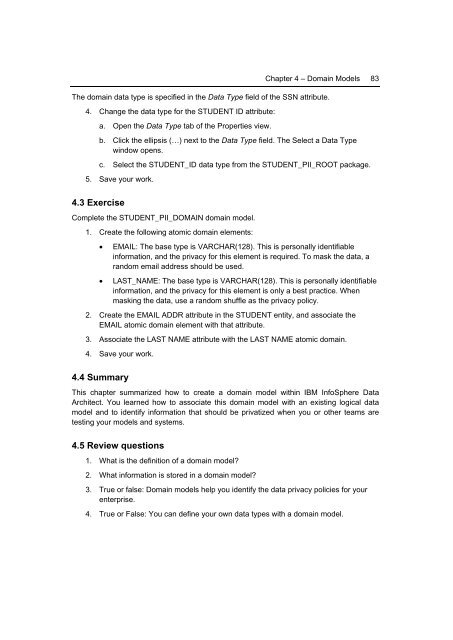Getting Started with InfoSphere Data Architect
You also want an ePaper? Increase the reach of your titles
YUMPU automatically turns print PDFs into web optimized ePapers that Google loves.
Chapter 4 – Domain Models 83<br />
The domain data type is specified in the <strong>Data</strong> Type field of the SSN attribute.<br />
4. Change the data type for the STUDENT ID attribute:<br />
a. Open the <strong>Data</strong> Type tab of the Properties view.<br />
b. Click the ellipsis (…) next to the <strong>Data</strong> Type field. The Select a <strong>Data</strong> Type<br />
window opens.<br />
c. Select the STUDENT_ID data type from the STUDENT_PII_ROOT package.<br />
5. Save your work.<br />
4.3 Exercise<br />
Complete the STUDENT_PII_DOMAIN domain model.<br />
1. Create the following atomic domain elements:<br />
• EMAIL: The base type is VARCHAR(128). This is personally identifiable<br />
information, and the privacy for this element is required. To mask the data, a<br />
random email address should be used.<br />
• LAST_NAME: The base type is VARCHAR(128). This is personally identifiable<br />
information, and the privacy for this element is only a best practice. When<br />
masking the data, use a random shuffle as the privacy policy.<br />
2. Create the EMAIL ADDR attribute in the STUDENT entity, and associate the<br />
EMAIL atomic domain element <strong>with</strong> that attribute.<br />
3. Associate the LAST NAME attribute <strong>with</strong> the LAST NAME atomic domain.<br />
4. Save your work.<br />
4.4 Summary<br />
This chapter summarized how to create a domain model <strong>with</strong>in IBM <strong>InfoSphere</strong> <strong>Data</strong><br />
<strong>Architect</strong>. You learned how to associate this domain model <strong>with</strong> an existing logical data<br />
model and to identify information that should be privatized when you or other teams are<br />
testing your models and systems.<br />
4.5 Review questions<br />
1. What is the definition of a domain model?<br />
2. What information is stored in a domain model?<br />
3. True or false: Domain models help you identify the data privacy policies for your<br />
enterprise.<br />
4. True or False: You can define your own data types <strong>with</strong> a domain model.

















